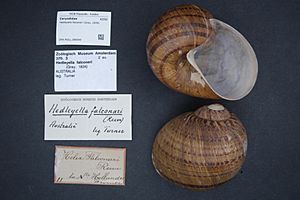Giant panda snail facts for kids
Quick facts for kids Giant panda snail |
|
|---|---|
 |
|
| Scientific classification | |
| Kingdom: | |
| Phylum: | |
| Class: | |
| (unranked): |
clade Heterobranchia
clade Euthyneura clade Panpulmonata clade Eupulmonata clade Stylommatophora informal group Sigmurethra |
| Family: |
Caryodidae
|
| Genus: |
Hedleyella
|
| Species: |
H. falconeri
|
| Binomial name | |
| Hedleyella falconeri (Grey, 1834)
|
|
The Hedleyella falconeri, also known as the giant panda snail, is a very large land snail. It breathes air and lives on land. This amazing snail belongs to the mollusc family called Caryodidae. It is the biggest land snail you can find in Australia.
Contents
About the Giant Panda Snail
The Hedleyella falconeri has a helicoid (spiral) shell. It can grow to be about 10 centimeters (4 inches) tall. Its shell is usually some shade of brown. It has irregular black bands and splotches that look like stripes.
What it Looks Like
When the snail is resting, its head and foot pull back into its shell. But when it wants to move or eat, they stretch out. The top part of its head and foot has a net-like pattern in grey. The edge of its foot is bright orange.
The snail has two pairs of tentacles on its head. These tentacles can pull back inside. The top pair is twice as long as the bottom pair. The eyes are on the tips of the longer tentacles. A dark line runs from between its tentacles down its neck.
Where the Giant Panda Snail Lives
The Hedleyella falconeri lives in the warm, wet eastern parts of Australia. You can find it from Smiths Lake in New South Wales up to just north of Brisbane. Its home stretches west to the Great Dividing Range.
Its Home in the Forest
This snail likes to live on the forest floor. It hides among leaf litter (fallen leaves and twigs) and mossy logs. It usually stays close to the ground. Scientists have not seen it climb higher than about 0.5 meters (1.6 feet) up trees.
Life of the Giant Panda Snail
The Hedleyella falconeri is a nocturnal animal. This means it is active mostly at night. During the day, it stays still. It might hide under a rotting log or other safe spot. Sometimes, it just stays in the open. Even then, it is often partly covered by leaf litter.
Movement and Activity
Most nights, the snail starts to move around and look for food. It especially likes wet nights. One study found that a snail moved about 8.7 meters (28.5 feet) on a night it was active. It seemed to wander randomly. It did not appear to have a special place it returned to.
What the Snail Eats
The Hedleyella falconeri is a fungivore. This means it eats fungi. It likes to munch on mushrooms like Polyporus varius. It also eats the bioluminescent fungus Omphalotus nidiformis. This fungus actually glows in the dark! The snail might also eat rotting leaves from the forest floor.
Who Eats the Snail
Some birds like to eat the giant panda snail. The noisy pitta (Pitta versicolor) is one of them. This bird smashes the snail's shell on a hard surface to get to the soft body inside. Other birds that eat it include the Albert's lyrebird (Menura alberti) and the superb lyrebird (Menura novaehollandiae).
Reproduction and Life Cycle
The Hedleyella falconeri is a hermaphrodite. This means each snail has both male and female reproductive parts. Mating usually happens in February. Two snails come together and spend the night. Each snail gives a sac of sperm to the other.
Fertilization happens inside the snail's body. Later, each snail lays a batch of up to twenty eggs. These eggs are cream-colored and almost perfectly round. Each egg weighs about 2 grams (0.07 ounces) and is about 18 millimeters (0.7 inches) across. The snails bury their eggs in a small hole under the leaf litter. The eggs take about six weeks to hatch. The young snails that come out are about 18 millimeters long. They grow slowly over time.
Images for kids


